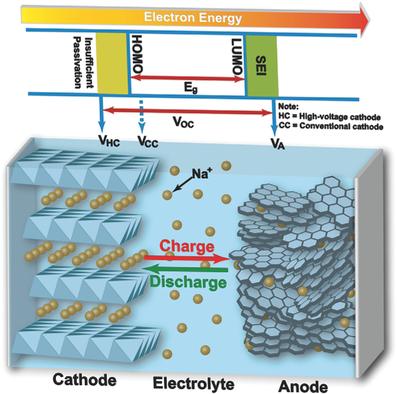当前位置:
X-MOL 学术
›
Adv. Energy Mater.
›
论文详情
Our official English website, www.x-mol.net, welcomes your feedback! (Note: you will need to create a separate account there.)
Progress in High‐Voltage Cathode Materials for Rechargeable Sodium‐Ion Batteries
Advanced Energy Materials ( IF 27.8 ) Pub Date : 2017-09-18 , DOI: 10.1002/aenm.201701785 Ya You 1 , Arumugam Manthiram 1
Advanced Energy Materials ( IF 27.8 ) Pub Date : 2017-09-18 , DOI: 10.1002/aenm.201701785 Ya You 1 , Arumugam Manthiram 1
Affiliation

|
Room‐temperature rechargeable sodium‐ion batteries are considered as a promising alternative technology for grid and other storage applications due to their competitive cost benefit and sustainable resource supply, triumphing other battery systems on the market. To facilitate the practical realization of the sodium‐ion technology, the energy density of sodium‐ion batteries needs to be boosted to the level of current commercial Li‐ion batteries. An effective approach would be to elevate the operating voltage of the battery, which requires the use of electrochemically stable cathode materials with high voltage versus Na+/Na. This review summarizes the recent progress with the emerging high‐voltage cathode materials for room‐temperature sodium‐ion batteries, which include layered transitional‐metal oxides, Na‐rich materials, and polyanion compounds. The key challenges and corresponding strategies for these materials are also discussed, with an emphasis placed on the intrinsic structural properties, Na storage electrochemistry, and the voltage variation tendency with respect to the redox reactions. The insights presented in this article can serve as a guide for improving the energy densities of room‐temperature Na‐ion batteries.
中文翻译:

可充电钠离子电池高压阴极材料的研究进展
室温可充电钠离子电池由于具有竞争优势的成本优势和可持续的资源供应,被认为是网格和其他存储应用中的有前途的替代技术,在市场上击败了其他电池系统。为了促进钠离子技术的实际实现,需要将钠离子电池的能量密度提高到目前商用锂离子电池的水平。一种有效的方法是提高电池的工作电压,这需要使用电化学稳定的阴极材料,其相对于Na +的电压高/不。这篇综述总结了用于室温钠离子电池的新兴高压阴极材料的最新进展,其中包括层状过渡金属氧化物,富钠材料和聚阴离子化合物。还讨论了这些材料的主要挑战和相应的策略,重点放在固有的结构特性,Na储存电化学和相对于氧化还原反应的电压变化趋势上。本文提供的见解可作为改善室温Na-离子电池能量密度的指南。
更新日期:2017-09-18
中文翻译:

可充电钠离子电池高压阴极材料的研究进展
室温可充电钠离子电池由于具有竞争优势的成本优势和可持续的资源供应,被认为是网格和其他存储应用中的有前途的替代技术,在市场上击败了其他电池系统。为了促进钠离子技术的实际实现,需要将钠离子电池的能量密度提高到目前商用锂离子电池的水平。一种有效的方法是提高电池的工作电压,这需要使用电化学稳定的阴极材料,其相对于Na +的电压高/不。这篇综述总结了用于室温钠离子电池的新兴高压阴极材料的最新进展,其中包括层状过渡金属氧化物,富钠材料和聚阴离子化合物。还讨论了这些材料的主要挑战和相应的策略,重点放在固有的结构特性,Na储存电化学和相对于氧化还原反应的电压变化趋势上。本文提供的见解可作为改善室温Na-离子电池能量密度的指南。



























 京公网安备 11010802027423号
京公网安备 11010802027423号